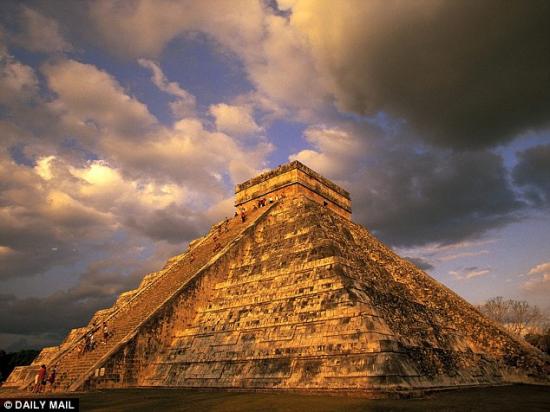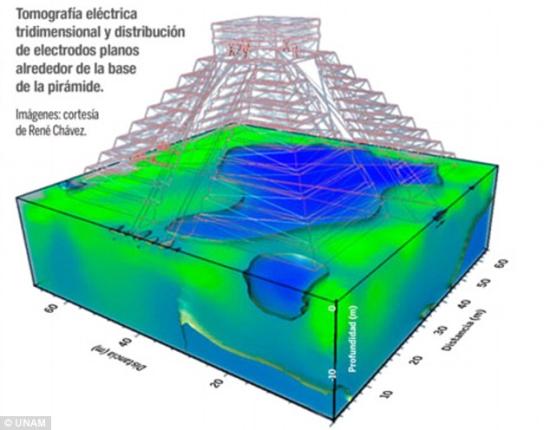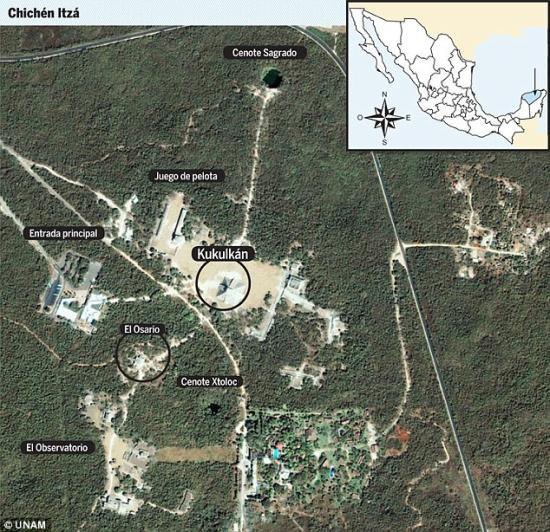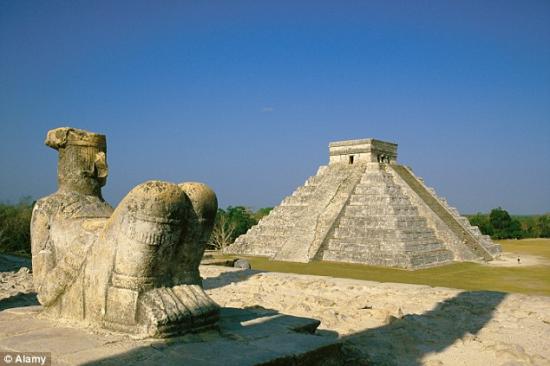Richard Gray
Source - http://www.dailymail.co.uk/sciencetech/article-3200817/Sacred-sinkhole-discovered-1-000-year-old-Mayan-temple-eventually-destroy-pyramid.html#ixzz3j5j0KCmy
It is a towering testament to a long dead civilisation and has fascinated archaeologists for more than 150 years, but one of the most famous Mayan pyramids has been hiding a secret beneath its mighty steps.
Researchers have discovered an enormous sinkhole beneath the 1,000-year-old Temple of Kukulkan, also known as El Castillo, which dominates the Mayan city of Chichen Itza in the northern Yucatan Peninusula of Mexico.
And they fear the underground cavern, or cenote, which has a river running through it, may eventually cause the entire pyramid to collapse if its roof gives way.
 Archaeologists have discovered the Temple of Kukulkan, which was built by the Maya around 1,000 years ago to worship a snake god, has a huge cenote, or sinkhole, beneath it. They believe it may have been built on top of the cavern deliberately as it may have had deep religious significance to the ancient civilisation
Archaeologists have discovered the Temple of Kukulkan, which was built by the Maya around 1,000 years ago to worship a snake god, has a huge cenote, or sinkhole, beneath it. They believe it may have been built on top of the cavern deliberately as it may have had deep religious significance to the ancient civilisation
Experts believe the huge chamber may have had special significance for the Mayans, who worshipped at the pyramid, as it is thought to be connected to other sinkhole lakes that surround the pyramid by underground rivers.
It may also be linked to another location known as the High Priest's Grave, or the Ossuary, a smaller pyramid with a sanctuary in the centre which was used as a communal graveyard.
Andrés Tejero-Andrade, one of the archaeologists at Mexico’s National Autonomous University who have been leading the research, said the Mayans may have built the Temple of Kukulkan around 900 to 1,100 years ago on top of the cavern as part of their religious beliefs.
Kukulkan is a Mayan snake deity, or a feathered serpent, who grew up inside and cave before emerging in an earthquake.
Dr Tejero-Andrade said the pyramid may have been built to symbolise the underworld, creation and water.
He said: ‘It appears that El Castillo is dedicated to that element and talk of a water Kukulcan, a snake moving in the water.’
The forming sinkhole beneath the temple is around 82 feet (25 metres) by 114 feet (35 metres) and up to 65 feet deep (20 metres).
The water filling the cavern is thought to run from north to south.
The researchers, who are due to present their findings at an international geophysics conference in Turin in Italy next month, made the discovery using a technique known as an electrical resistance survey.
This uses metal probes inserted into the ground to get a reading for resistance of electrical flow though the ground. Where there is water the resistance changes compared to the rock.
Empty air has a very high resistance reading as the current cannot pass through the air while it is easily transmitted through water.
The researchers say they found there is a layer of limestone about 16ft (5 metres) thick at the top of the cenote, which the pyramid is currently sitting on.
Dr Rene Chavez Segura, a geologist with the National Autonomous University in Mexico, said the high humidity in the cavern and running water could eventually undermine the pyramid.
He said: "Such structures change over time, because the water washed off the walls and the cavity may be increasing.
‘At some point, if the thickness of the rock below the pyramid is thinned, there could be a problem of stability and El Castilla will collapse.’
However, he added this may not happen within his lifetime or even for many generations to come.
 The researchers used a technique known as an electrical resistance survey to measure the ground beneath the Temple of Kukulkan. They found a large 65 feet deep cavern beneath the pyramid which has water running through it, as shown in the graphic above. Experts fear it may eventually collapse and destroy the structure
The researchers used a technique known as an electrical resistance survey to measure the ground beneath the Temple of Kukulkan. They found a large 65 feet deep cavern beneath the pyramid which has water running through it, as shown in the graphic above. Experts fear it may eventually collapse and destroy the structure
The researchers also found the cenote under the pyramid is also connected to underground caverns and sinkhole lakes to the north, west and east of the pyramid.
Dr Chavez Segura said: "This is not uncommon in a karst soil and the Yucatan.
‘Usually, at depth, the cenotes are interconnected and form a network of tunnels where the water runs free. This forms the natural water network on the peninsula.’
In some areas of Mexico cenotes were used as natural wells or water supplies for ancient civilisations.
The name Chichen Itza also means "at the mouth of the well of the Itza' - the Mayan ethnic group that ruled the area..
Archaeologist Guillermo de Anda, who was not involved in the study, said the underground network of tunnels and caverns may have been symbolic to the Mayans.
 Experts say the underground cavern is also connected to other sinkholes and caverns to the north, east and west of the Kukulkan pyramid, including the High Priest's grave, marked El Osario in the map above
Experts say the underground cavern is also connected to other sinkholes and caverns to the north, east and west of the Kukulkan pyramid, including the High Priest's grave, marked El Osario in the map above
 The Temple of Kukulcan at Chichen Itza is thought to have been built for the worship of the Mayan snake deity. As a result the water and underground cavern may have been significant in its construction, say experts
The Temple of Kukulcan at Chichen Itza is thought to have been built for the worship of the Mayan snake deity. As a result the water and underground cavern may have been significant in its construction, say experts
He said the cenotes that surround the pyramid could represent the four points of the compass.
The river at the center might represent the center of the Maya's universe, which they thought of as a tree with roots reaching below ground.
The National Institute of Anthropology and History also said research at another Mayan site, Uxmal, found an usually high number of medicinal plants growing nearing the structure known as the governor's palace.
Uxmal site director Jose Huchim Herrera said the concentration of such plants was so much higher in the sacred area than in surrounding fields, that it indicates the Mayas planted them there intentionally as a sort of medicinal garden. The site has about 150 species used to treat snake bites, stomach infections and fevers.